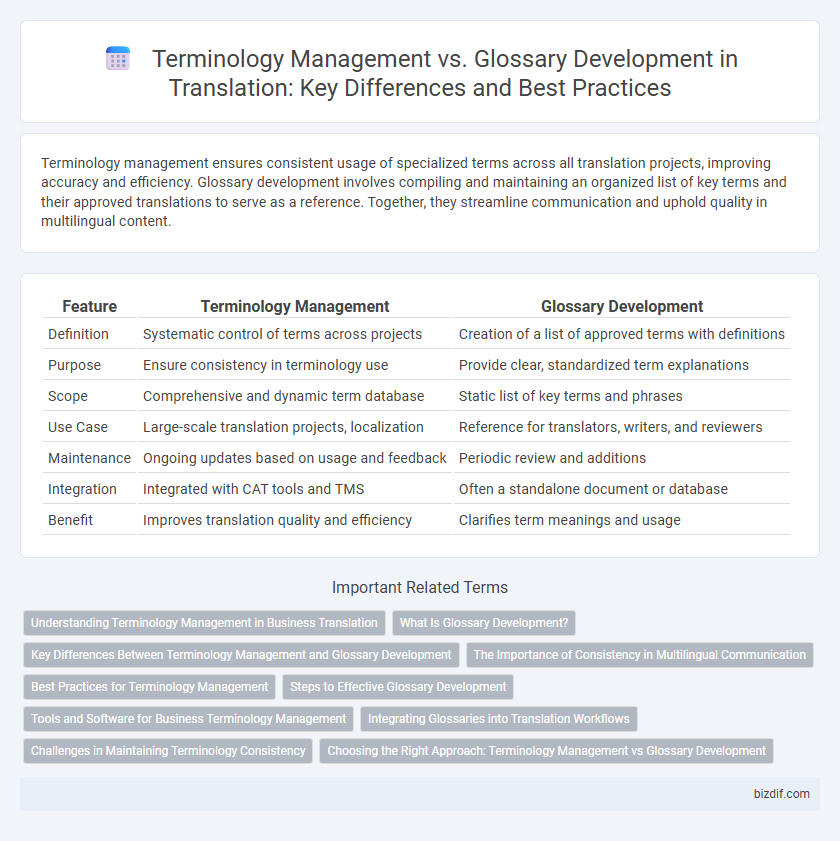Terminology management ensures consistent usage of specialized terms across all translation projects, improving accuracy and efficiency. Glossary development involves compiling and maintaining an organized list of key terms and their approved translations to serve as a reference. Together, they streamline communication and uphold quality in multilingual content.
Table of Comparison
| Feature | Terminology Management | Glossary Development |
|---|---|---|
| Definition | Systematic control of terms across projects | Creation of a list of approved terms with definitions |
| Purpose | Ensure consistency in terminology use | Provide clear, standardized term explanations |
| Scope | Comprehensive and dynamic term database | Static list of key terms and phrases |
| Use Case | Large-scale translation projects, localization | Reference for translators, writers, and reviewers |
| Maintenance | Ongoing updates based on usage and feedback | Periodic review and additions |
| Integration | Integrated with CAT tools and TMS | Often a standalone document or database |
| Benefit | Improves translation quality and efficiency | Clarifies term meanings and usage |
Understanding Terminology Management in Business Translation
Terminology management in business translation ensures consistent use of specialized terms across all documents, enhancing clarity and brand integrity. It involves creating, updating, and controlling a structured database of terms aligned with industry standards and company-specific language. This systematic approach surpasses glossary development by integrating term accuracy into the translation workflow, reducing errors and improving communication efficiency.
What Is Glossary Development?
Glossary development involves the systematic creation and organization of a list of specialized terms and their definitions within a specific domain or project to ensure consistent usage. It enhances communication clarity by providing translators and stakeholders with a reference for accurate terminology application. Glossaries typically support terminology management systems by acting as foundational resources for maintaining linguistic consistency across multilingual content.
Key Differences Between Terminology Management and Glossary Development
Terminology management involves systematically organizing and maintaining a comprehensive database of domain-specific terms, ensuring consistency across translations by integrating with translation memory tools. Glossary development focuses on creating a curated list of essential terms and their agreed-upon definitions to guide translators and subject matter experts during specific projects. Key differences lie in scope: terminology management is an ongoing, dynamic process for enterprise-wide consistency, while glossary development is project-specific and often less detailed.
The Importance of Consistency in Multilingual Communication
Terminology management ensures consistent use of specialized terms across all languages, reducing misunderstandings and enhancing clarity in multilingual communication. Glossary development supports this by compiling agreed-upon terms with precise definitions, serving as a reliable reference for translators and content creators. Consistent terminology bridges language barriers, improves brand identity, and streamlines translation workflows for global audiences.
Best Practices for Terminology Management
Effective terminology management maximizes consistency across multilingual content by creating comprehensive, regularly updated termbases that reflect industry-specific standards and client preferences. Implementing centralized, collaborative platforms ensures real-time updates and stakeholder alignment, reducing translation errors and improving localization quality. Integrating automated quality checks and continuous feedback loops strengthens terminology accuracy, fostering clearer communication and brand coherence.
Steps to Effective Glossary Development
Effective glossary development begins with thorough terminology extraction from source texts to identify relevant domain-specific terms. Next, terms should be standardized through collaboration with subject matter experts to ensure accuracy and consistency. Finally, implementing a centralized, easily accessible digital platform for ongoing updates enhances translation quality and maintains terminology consistency across projects.
Tools and Software for Business Terminology Management
Terminology management tools like SDL MultiTerm and memoQ support comprehensive business terminology management by offering centralized databases, real-time updates, and integration with translation workflows. Glossary development software, such as TermWiki and Terminology.net, typically focus on creating and maintaining term lists without advanced collaborative features or automated consistency checks. Effective business terminology management relies on robust software solutions that ensure term accuracy, consistency across documents, and seamless collaboration among translators and subject matter experts.
Integrating Glossaries into Translation Workflows
Integrating glossaries into translation workflows enhances terminology management by providing translators with consistent, standardized vocabulary, reducing errors and improving quality. Utilizing terminology management systems allows seamless updates and real-time access to glossary entries, streamlining the translation process across multiple projects. This integration supports efficiency and coherence, ensuring that specialized terms are uniformly applied in all translated content.
Challenges in Maintaining Terminology Consistency
Terminology management ensures the systematic organization and standardization of terms across multiple projects, but challenges arise due to evolving language use, inconsistent term adoption, and integration with translation memory systems. Glossary development creates a curated list of approved terms, yet maintaining consistency becomes difficult when glossaries are updated irregularly or lack comprehensive stakeholder input. Both processes require continuous collaboration, version control, and quality assurance to prevent discrepancies that can impact translation accuracy and brand messaging.
Choosing the Right Approach: Terminology Management vs Glossary Development
Selecting the right approach between terminology management and glossary development hinges on the scale and complexity of the translation project. Terminology management offers dynamic control over consistent term usage across multiple languages and platforms through specialized software, enhancing accuracy for large-scale or ongoing projects. Glossary development suits smaller or one-time translation tasks by providing a static, curated list of key terms to maintain clarity and uniformity.
Terminology Management vs Glossary Development Infographic

 bizdif.com
bizdif.com